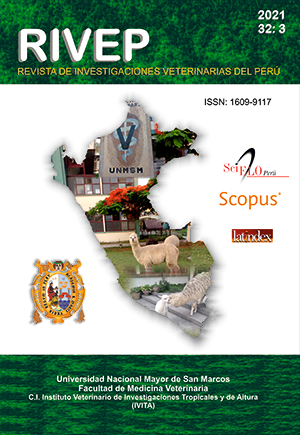Genetic effect of sires used via artificial insemination on dairy production at the El Mantaro experimental station, Junín, Peru
DOI:
https://doi.org/10.15381/rivep.v32i3.20400Keywords:
bulls, fixed effect, random effect, breeding value, corrected phenotypeAbstract
The present study aimed to determine the contribution of the genetic effect of bulls used via artificial insemination on the dairy production of Brown Swiss cows from the El Mantaro Agricultural Experiment Station of the National University of Central Peru, in terms of daily milk production (PLD) and by lactation (PLC). In total, 112 lactations were used, from a total of 49 cows, daughters of 7 Brown Swiss bulls, standardized to 305 days (PLE) and two milking by non-linear projection. The statistical analysis was carried out by using a mixed linear model, considering as fixed factors the number of lactations, year, season and age at calving of the cow, and as a random factor the genetic effect of the bull. Corrected phenotypic means were obtained for PLD and PLC with the correction factors obtained from the model, and predictions of the predicted transmission ability (PTA) of the evaluated bulls and their respective precisions. The corrected phenotypic means ranged from 9.39 ± 0.62 kg to 12.18 ± 0.87 kg for PLD and from 3 218.8 ± 40.2 kg to 4 690.4 ± 54.6 kg for PLC, while the PTA of the bulls ranged from -2.82 to 1.98 kg/day for PLD and from -841.55 to 630.33 kg/lactation for PLC, registering precision levels of 58.87 to 78.34%. The results show an important differential in the genetic level of the bulls and the potential use of some to contribute to the increase in milk production in the study area.
Downloads
Downloads
Published
Issue
Section
License
Copyright (c) 2021 Elmer Meza R., Javier Orellana C., Luís Astuhuamán P.

This work is licensed under a Creative Commons Attribution 4.0 International License.
AUTHORS RETAIN THEIR RIGHTS:
a. Authors retain their trade mark rights and patent, and also on any process or procedure described in the article.
b. Authors retain their right to share, copy, distribute, perform and publicly communicate their article (eg, to place their article in an institutional repository or publish it in a book), with an acknowledgment of its initial publication in the Revista de Investigaciones Veterinarias del Perú (RIVEP).
c. Authors retain theirs right to make a subsequent publication of their work, to use the article or any part thereof (eg a compilation of his papers, lecture notes, thesis, or a book), always indicating the source of publication (the originator of the work, journal, volume, number and date).



